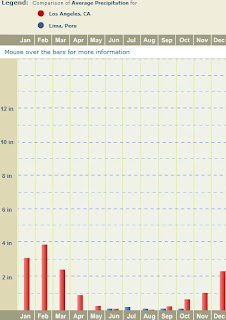Both coastal cities on the Pacific Ocean, Lima and Los Angeles share many differences and similarities.
Although the seasons are variedbetween the north and south hemispheres, the temperatures in Los Angeles and Lima remain very steady and similar throughout their seasons.
Although the seasons are variedbetween the north and south hemispheres, the temperatures in Los Angeles and Lima remain very steady and similar throughout their seasons.
(weather.com)
Lima has a much lower precipitation rate due to the Andes Mountains. Los Angeles also experiences fairly low precipitation, but this is due to the dominance of the stable marine layer. Precipitation is rare between May and October and any rain that does occur is usually the result of isolated thunderstorms associated with subtropical moisture. During the remainder of the year the eastern Pacific high pressure ridge is displaced and Los Angeles finds itself on the southern margins of the northern hemisphere polar jet stream. With cold air aloft, the marine layer breaks down. Pacific storms, sometimes fed with subtropical moisture, often push cold fronts across California from northwest to southeast.(http://www.wrh.noaa.gov/lox/climate/climate_intro.php)
(weather.com)
Both Lima and Los Angeles experience weather due to maritime air masses, where both are influenced by polar air, Los Angeles is also greatly influenced by subtropical air.




